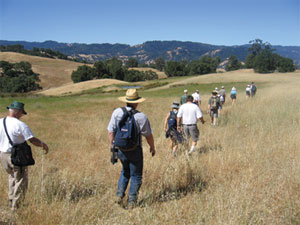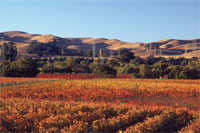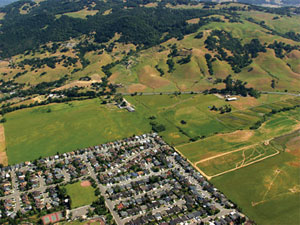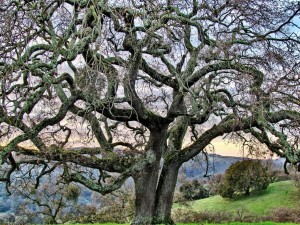Sometimes nothing much happening is the biggest news of all.
East of Tomales Bay in Marin County is a world of humpbacked ridges and hidden valleys, Irish green in the spring, in the summer yellowed by sun and cooled by fog. Unless it is that the grass is a little thicker and the fences a little better maintained, the scene has hardly altered in 50 years. Driving along some wandering road, you wouldn’t dream how close this region came to being just another slice of suburbia, nor recognize what forces are operating to keep it intact. A small sign hanging at the gate of a ranch road gives a clue. “This farmland is preserved in perpetuity by the owners and the Marin Agricultural Land Trust,” it reads. “Private Property. No Trespassing.”
“Preserved. . . . No trespassing.” This combination of concepts, a little unfamiliar perhaps, is a sign of the land use times.
-
On the western flank of Sonoma Mountain, the town of Rohnert Parkcomes to an abrupt halt where it meets the 73-acre Oken property,protected in perpetuity by the Sonoma County Agriculture Preservationand Open Space District. Photo by Stephen Joseph, www.stephenjosephphoto.com.
The hottest tool in landscape protection these days is the conservation easement. It is a contract by which a landowner gives up the right to develop property, and usually agrees to other restrictions, in return for money (or a tax deduction). Once made, the contract runs with the land and is valid forever. Easements are acquired and held by government agencies or by private nonprofit organizations called land trusts. Easement holders visit to make sure promises are kept, but the public comes onto the land by arrangement only.
Land under conservation easement has many of the qualities we expect of public open space. It is scenery, enjoyed by drivers, bicyclists, or walkers on public roads and trails nearby. It is habitat, providing living space for plants and animals and corridors for wildlife movement. It is watershed and airshed, absorbing rainfall, yielding streams, and helping to clean the air. It may be farm or ranch land, supporting agriculture as a livelihood and a source of locally grown food. It is greenbelt, setting limits to urban sprawl. And while easement land is not accessible parkland, it is a great deal cheaper than parkland to set aside and to maintain.
REMARKABLE GROWTH
Easements—voluntary modifications of ownership—have existed since the 16th century as transactions between neighbors. One owner may buy an easement from another, for instance, to run a power line or access road across adjoining land. By the 1970s, easements were beginning to be tailored to foreclose development and protect farmland and wildlife habitat. Most states and the federal government passed laws endorsing and codifying this practice; California’s Conservation Easement Enabling Act dates to 1975.
In the 1980s the use of conservation easements grew; in the 1990s, it exploded. Just how much land is now under contract nationwide is unclear, but it is not less than 9 million acres and possibly double that when government-owned easements are counted. Indeed, easements appear to be supplanting acquisition (often called “fee title” or “fee simple”) as the nation’s number one land protection tool.

-
Many land trusts provide opportunities for public access toproperties under easement. Here, hikers on a LandPaths outing explorethe extensive grasslands of the Cooley Ranch near Cloverdale. Photo byJonathan Glass, www.landpaths.org.
The pattern repeats itself in the Bay Area: slow beginnings in the 1970s, healthy growth in the 1980s, and a veritable boom thereafter. As of 1999, at least 85,000 acres were under easement in the region; by 2005, that figure had surpassed 150,000 acres (out of a total of 1.07 million acres of protected lands in the nine-county region). The largest single easement holder is the Sonoma County Agricultural and Open Space Conservation District, followed by the Marin Agricultural Land Trust, the Land Trust of Napa County, and the Peninsula Open Space Trust. More than half of the region’s easement acreage is found in the North Bay. Of the acreage protected by easements, about half was purchased for cash and about a quarter was donated (with tax deductions); the rest was dedicated as a condition of development, or represents easements retained when a wholly owned conservation property was sold. “Agriculture,” “open space,” and “natural resources” are cited about equally as the values to be protected.
Nobody quite realized the scale of this phenomenon until the late 1990s, when the San Francisco Bay Area Open Space Council (a working alliance of private and public land management entities) set out to build an inventory of protected open spaces. “We were astonished,” researcher Darla Guenzler recalls, “to find that more than half of the new land protection in the 1990s had been by conservation easement.” With so much reliance on this tool, it was obviously time for a look at its effectiveness. The resulting study of easements and the organizations that hold them, “Ensuring the Promise of Conservation Easements,” did much to codify good practice—and to point out certain areas for improvement.
Since then the easement movement has only continued to grow, lately attracting attention outside traditional conservation circles, some of it very critical.
It is plain that all citizens have an interest here. Even when government money is not directly spent on easements, the public purse is inevitably affected: through lower property tax receipts, for example, or by federal income tax write-offs taken by easement donors or contributors to land trust treasuries. It is therefore not out of order to ask: Are we getting our money’s worth?
THE CHARMS OF EASEMENTS
The first selling point of easements is simply their price. In the Bay Area, easements generally cost about half as much as fee simple acquisition. With land prices ratcheting upward and park budgets on the decline, the appeal is clear.
Further savings come in long-term management. A park is a public expense for generations to come; on an easement property, the owner bears the bulk of the maintenance costs. Especially in areas where traditional parks are plentiful (and their upkeep a large budget item), easement programs become an attractive supplement. The easement strategy also leaves land on the tax rolls, with considerable though reduced appraised value, a big plus for local governments.
That’s the money side. But experience shows that the advantages of easements go well beyond cost. Unlike traditional acquisition, which displaces residents, easement purchase leaves them in place. And the stewardship that happens when private owners and easement holders collaborate may not only be cheaper than what public managers could provide, but also better.
There are obviously also purposes that easements do not serve. If letting the public onto the property is a priority, the land should be bought outright. Fee simple ownership is also often the best way to ensure protection of key habitats for rare, threatened, or endangered species.
Where conservation easements really shine is in the protection of agricultural landscapes and livelihoods. When farmers receive cash for easements—the usual case in the Bay Area—agriculture is supported in two ways: by the restriction itself, which removes the temptation to subdivide or sell for development; and by the infusion of cash, which usually goes to improve the operation. More subtly, the knowledge that some farmers have made the easement commitment encourages others to think in terms of remaining on the land for the long haul. Rural communities and economies are thus strengthened, not weakened, by this form of preservation.
SOME CHALLENGES
For all their selling points, easement programs have their detractors. One fundamental challenge comes from those in the environmental movement who long for stronger land use regulation in the United States and see easements as an expensive substitute that overvalues private property rights. Thus, John Echeverria, director of the Georgetown Environmental Law and Policy Institute in Washington D.C., complains, “The message to landowners is that they’re only required to do what they want to do and are paid to do.”
Indeed, among conservatives, the easement approach has generally passed muster with property rights advocates. The Bush administration, for example, supports it. But a few voices denounce even voluntary land use restrictions. Carol LaGrasse of the Property Rights Foundation of America writes, “This is just one more nail in the coffin of private property ownership in rural America.”
Unlike these broad attacks, other criticisms point to growing pains in this area of practice and identify problems that are in principle fixable. Three main challenges seem to face the acquirers and holders of easements: making sure that the tool is not abused as a tax shelter without corresponding public benefit; gearing up for long-term stewardship; and balancing the public’s need for information with the landowner’s wish to keep private property private and the steward’s duty to keep some sensitive facts obscure.
Tax Issues
Easements cost the taxpayers money, one way or another. Most are plainly worth it; some may not be. It’s the donation of easements that has shown potential for abuse. Unlike the landowner who sells an easement to a negotiating partner, the owner who gives an easement can shop around for an inflated appraisal and deduct that value, with no one to cry foul. Games have been played, as when the developers of golf-centered communities “donate” conservation easements on the fairways. Congress has made noises about limiting deductions, which alarms those in charge of land trusts that rely on tax incentives to get legitimate donors in the door.
Experts see the solution in a tightening up of appraisal practices. The Internal Revenue Service could, for instance, require the use of state-licensed appraisers, as (astonishingly) it now does not. Umbrella groups like the national Land Trust Alliance and the state California Council of Land Trusts plan to offer courses to help appraisers unfamiliar with easement practice get up to speed.
The Long Haul
The 1999 Bay Area Open Space Council report challenged easement holders to come to grips with what it means to be responsible for an easement forever. The study found that only about half of the agencies holding easements had good inventories of the lands they had undertaken to protect, and only about half of the properties were regularly visited by the easement holders. Private land trusts, as well as the Sonoma County Agricultural and Open Space District, were doing the best job; state and federal agencies were sloppiest. The study also found that property owners (and sometimes their neighbors) were more inclined than expected to do things on the land that violated easement terms. As the original contracting landowners are replaced by heirs or buyers, the report concluded, “disputes are inevitable for most easements.” The authors urged land trusts to establish permanent endowments to make sure that their investments could be defended on the ground and in the courts well into the future.
Public Information
The summary figures used in this article are little more than educated guesses. Even in a well-studied region like the Bay Area, nobody knows where all the easements are or how many acres are covered. The larger land trusts track and trumpet their accomplishments, but the same is not true of most government bodies. State and federal agencies that hold just a few easements tend to forget about them. Local governments often require developers to dedicate easements as “mitigation” for environmental damage done, but rather rarely keep tabs on the results over time.
Most easements are recorded, of course, and reside as public records in county assessors’ offices. In 2002, a state law required counties to keep indexes making it easier to locate easement documents. Research is still laborious, so the thought arises: why not put this information online?
Here caution flags go up. Land trusts are nervous about having too much data too accessible. Easement documents often give details about vulnerable features like rare plants or archeological sites, already difficult enough to protect from poachers and artifact hunters. Landowners have their privacy concerns as well.
The Bay Area Open Space Council faced this issue as it assembled its database of holdings, and settled on a compromise format that shows location, size, and ownership, but does not describe the properties in any way, and invariably includes the line “no public access”—although one third of owners in fact do allow some form of controlled public visitation.
THE BIG PICTURE
The Bay Area Open Space Council website (though in need of an update) is a feast for the map junkie. Pick a county and start looking at what’s there, and you may be amazed at the scale of protection that exists. In Marin County, for example, easement-protected farmlands are steadily filling in the interior wedge between the great coastal parks, Point Reyes National Seashore and the Golden Gate National Recreation Area, and a thinner band of public open space that seals the border of the eastern urban zone. On the Peninsula, easements are helping to complete a vast arc of protected land that extends from the sea cliffs at Devil’s Slide along the Santa Cruz Mountains crest, then down to the coast near Santa Cruz, with spokes of greenbelt extending to the shore at several points in between. Another vast expanse is coalescing in the Diablo Range east of San Jose. Here the Nature Conservancy is taking the lead in buying easements to fill the gaps in a 200,000-acre primitive stronghold, extending from the fringe of the Livermore Valley over the Sunol-Ohlone ridge to Mount Hamilton and on south to Henry Coe State Park east of Morgan Hill. In northern Sonoma County, too, notable clusters are forming both east and west of the Russian River. In each case, parks and other public lands provide for access, while the easements help create greater wholes than could be achieved without them.
Easements are at their best when they take their place in even larger strategies of land protection. Again the San Mateo coast offers an example. The goal that easements are helping to achieve—preservation of the rural landscape—is also honored in county plans and zoning, enforced on the immediate shoreline by the state Coastal Commission, buttressed by fee acquisitions, and supported by public and private funders. In an era of swelling land prices and omnipresent development pressure, it takes all hands and all tools to succeed.
How Easements (Should) Work
by John Hart

- Today, with the help of conservation easements, vineyards are makinga strong comeback in South Livermore. Photo by Steve Stewart.
Conservation easements are created by complex contracts in widely varying formats. The essential point, found in every such document, is the renunciation of whatever level of building would be allowed under local zoning, present or future, perhaps with the exception of one or a few individual dwellings. Contracts that go no further than extinguishing development rights are sometimes called open space easements. Agricultural easements actively foster, and may even require, farming of the land. Natural resources easements put the emphasis squarely on plants, animals, and streams. The boundaries between the types are not clear, however, and most contracts include at least some language about environmental management. Owners usually pledge to control soil erosion and water pollution, for example. Tree cutting is typically limited. Land grading, road construction, and new building require the easement holder’s approval. General though they sound, such provisions are powerful, for they make reasonably sensitive management a matter of duty, no longer only of good will.
In recent years, contracts have become more detailed and specific. For instance, they may require the protection of stream banks so that riparian vegetation can flourish. Sensitive plant and animal species may be identified and measures for their protection required. About one third of Bay Area easement contracts make some provision for public access by specifying corridors for future trails or by providing for guided public visits. It’s all a matter of negotiation—and of willingness to pay, because added stipulations add to the easement price.
To determine the value of the easement, an appraiser estimates the sales price of the property with and without the restriction. The owner may receive a check for the difference, or choose to donate part or all of this value, taking a charitable deduction on the federal tax return.
Other tax benefits accrue to the owner. Assessed valuation and property tax will either fall or, if already low due to Proposition 13 tax provisions, be left alone. On the owner’s death, estate taxes will also be less, due to lowered value as well as a higher base exemption for properties under easement.
To administer the contract, a two-step process has evolved. At the outset, an inventory, called the baseline, is made of the property and the resources the easement is designed to protect. Details are noted: the layout and condition of buildings and roads, the state of woods and grasslands, the health of streams, plant and animal species of concern, the presence of invasive plants, and so on. Good baselines are vital, both to avoid misunderstandings and because the cast of characters is going to change over the years, on both sides; general impressions and informal understandings won’t do.
Thereafter, a monitoring visit is made once a year to identify any changes. An eroded gully may be healing, for instance; but unwanted vegetation (like the hated pampas grass or broom) may be getting a grip. When problems arise a land trust may put the owner in touch with other organizations that can help, such as resource conservation districts or restoration volunteers. Though rare, overt violations, like bulldozing a new road or adding a building without approval, do happen occasionally.
Even when there is little to discuss, the annual visit serves to keep the lines of friendly communication open with owners or their representatives.
A tricky moment in the life of an easement comes when land ownership changes for the first time. Many successors are in the know, but some will be puzzled and displeased at the restrictions they must abide by. At a minimum, the working relationship between land owner and easement holder must be built anew—not just once, but many times over.

.jpg)



-300x199.jpg)
-300x150.jpg)